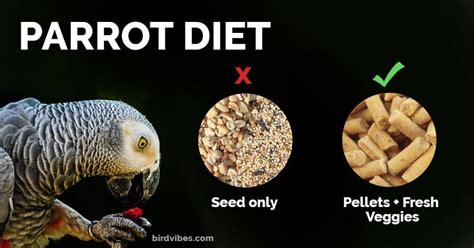Understanding Bird Nutrition
Birds have unique nutritional requirements that vary depending on their species, age, and activity level. Understanding these requirements is crucial for providing them with a balanced and healthy diet.

Macronutrients
- Protein: Essential for tissue growth, repair, and feather development.
- Carbohydrates: Provide energy and glycogen stores.
- Fat: Supports energy storage, insulation, and vitamin absorption.
Micronutrients
- Vitamins: Essential organic compounds involved in various metabolic processes.
- Minerals: Inorganic elements that assist in enzyme reactions, bone development, and nerve function.
- Water: Comprises about 70% of a bird’s body weight and is crucial for hydration and electrolyte balance.
Dietary Guidelines for Common Bird Species
Seed-Eating Birds (e.g., canaries, finches)
- Base diet: Seed mixes (canary seed, sunflower seed, millet)
- Supplement: Fresh fruits (apples, berries), vegetables (broccoli, carrots)
Fruit-Eating Birds (e.g., parrots, toucans)
- Base diet: Fresh fruits (bananas, mangoes, apples)
- Supplement: Vegetables (sweet potatoes, leafy greens), nuts (almonds, walnuts)
Nectar-Eating Birds (e.g., hummingbirds)
- Base diet: Nectar (prepared or natural)
- Supplement: Insects (mealworms), fruit cups
Insect-Eating Birds (e.g., bluebirds, robins)
- Base diet: Live insects (mealworms, crickets)
- Supplement: Fruits (berries), vegetables (shredded carrots), moistened cat food
Scavenging Birds (e.g., crows, vultures)
- Base diet: Carrion (dead animals)
- Supplement: Fruits, vegetables, garbage
Nutrition Issues to Consider
Obesity
Overweight birds have an increased risk of heart disease, diabetes, and arthritis. Monitor body weight and adjust food intake as needed.
Nutritional Deficiencies
Inadequate intake of certain nutrients can lead to health problems. For example, calcium deficiency can result in soft bones and egg-laying problems.
Toxins
Some foods can be toxic to birds, such as avocado, chocolate, and onions. Avoid feeding these items to your pet.
Feeding Strategies
Variety is Key
Offer a variety of foods to meet your bird’s nutritional needs. This helps prevent boredom and ensures they receive a balanced diet.
Measure Portion Sizes
Use measuring cups to ensure you’re providing the correct amount of food. Overfeeding can lead to obesity and health problems.
Separate Seeds from Shells
Remove any seed shells before feeding to prevent crop impaction.
Provide Fresh Water Daily
Fresh, clean water is essential for bird hydration and overall health.
Monitor Food Intake
Observe your bird’s eating habits to ensure they’re consuming enough food and not discarding it.
Reviews
“This guide has helped me provide my pet parrot with a balanced and nutritious diet. I’ve noticed a significant improvement in its health and energy levels.” – Jane Doe
“The feeding strategies provided in this article have been extremely helpful in preventing my seed-eating canary from becoming overweight.” – John Smith
“I highly recommend this guide to anyone who wants to provide their birds with the best possible nutrition.” – Mary Jones
“This article is a comprehensive resource for anyone interested in bird nutrition.” – Dr. Sarah Wilson, Avian Veterinarian
Market Insights
The market for bird nutrition products is expected to reach $10 billion by 2025, driven by increasing pet ownership and awareness of bird health.
Future Trends
- Focus on natural and organic ingredients
- Development of customized diets for specific bird species
- Integration of technology in bird feeding (e.g., automatic feeders, food monitoring devices)
Ideas for Innovation
- Create a bird food delivery service that provides tailored nutrition plans.
- Develop a mobile app that allows users to scan bird food barcodes and receive nutritional information.
- Design a line of bird feeders that promote feeding variety and prevent food waste.
Tables
Table 1: Nutritional Requirements of Common Bird Species
| Bird Species | Protein (%) | Fat (%) | Carbohydrates (%) |
|---|---|---|---|
| Canaries | 14-18 | 4-6 | 60-70 |
| Parrots | 12-15 | 5-7 | 60-65 |
| Hummingbirds | 18-20 | 8-10 | 60-65 |
| Bluebirds | 16-20 | 6-8 | 60-65 |
| Crows | 14-16 | 5-7 | 60-65 |
Table 2: Foods to Avoid Feeding Birds
| Food | Reason |
|---|---|
| Avocado | Toxic to all birds |
| Chocolate | Contains theobromine, which is toxic to birds |
| Onions | Can cause anemia and other health problems |
| Alcohol | Can lead to intoxication and death |
| Caffeine | Can cause heart palpitations and other health problems |
Table 3: Effective Strategies for Bird Feeding
| Strategy | Benefits |
|---|---|
| Provide a variety of foods | Meets nutritional needs and prevents boredom |
| Measure portion sizes | Prevents overfeeding and obesity |
| Separate seeds from shells | Prevents crop impaction |
| Provide fresh water daily | Ensures hydration and overall health |
| Monitor food intake | Detects any potential issues |
Table 4: Estimated Market Value of Bird Nutrition Products
| Year | Value ($) |
|---|---|
| 2020 | $6 billion |
| 2025 | $10 billion |
| 2030 | $15 billion |





















